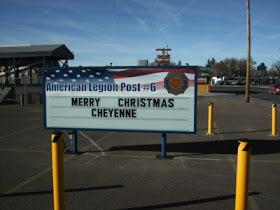
Each of my right side windows is packed with snow. [And I just realized...it's because the right side windows are the only ones with screens, which catch thesnow and don't let it fall out!]
Well, the headline is a bit overdramatic, we're not really trapped here in Cheyenne. My dad's got a truck - though it doesn't have 4-wheel drive - and the wind has blown most of the snow off the roads.
In any event, we've got food here for a couple of weeks (and more importantly I have Pepsi.) But I expect things will be back to normal in a few days. The main thing about the weather is that the wind is just blowing the snow horizontally across the ground, which makes being outside in it extremely unpleasant.
Here's some photos from my house. I live on the ground floor of the two story house.
You can't really see the snow blowing across the ground, but that's what it's doing. So there's a drift of snow right in front of the house, but only a bit of snow covering our yard. I've got three sets of windows in my bedroom (this house has a lot of windows), the left side of each window is clear, the right side, as you see, has snow packed in it.

The drift just outside the front door




















